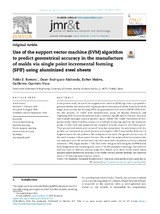Use of the support vector machine (SVM) algorithm to predict geometrical accuracy in the manufacture of molds via single point incremental forming (SPIF) using aluminized steel sheets
Author
Romero, Pablo E.
Rodríguez-Alabanda, O.
Molero, Esther
Guerrero-Vaca, G.
Publisher
ElsevierDate
2021Subject
Incremental formingMachine learning
Vector support machine
Geometrical accuracy
Multilayer
Aluminized steel
METS:
Mostrar el registro METSPREMIS:
Mostrar el registro PREMISMetadata
Show full item recordAbstract
In the present work, the use of the support vector machine (SVM) algorithm is proposed to generate models that allow predicting the geometrical accuracy of molds manufactured via single point incremental forming (SPIF) using aluminized steel sheets DX51D AS120 B CO. For this purpose, 27 molds were manufactured, using the dummy technique, and employing different process parameters (tool diameter, spindle speed, feed rate, step size) and toolpath strategies (contour-parallel, spiral, radial). The molds manufactured were geometrically characterized by means of a coordinate measuring machine: the transverse profile of each mold was measured and compared with the expected theoretical profile. Three geometrical values were extracted from this comparison: the area between the two profiles, the moment of inertia of this area with respect to the Y-axis and the difference in height between the two profiles at the mid-point of the mold. The geometrical accuracy of the mold increases if these values decrease. The model that achieved the best results is the one associated with the area between the theoretical and real profiles (correctly classified instances = 90%; kappa statistic = 0.8). This model was generated using the LibSVM (linear kernel) algorithm and evaluating only three of the five parameters (strategy, tool diameter and step size). In addition, process maps were drawn up to show briefly which values generate higher geometrical accuracy in the molds: contour-parallel strategy, tool diameter equal to 12 mm and small step size values.

